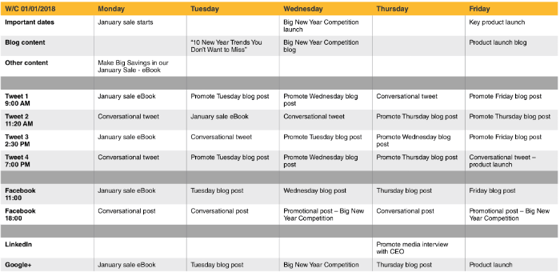Last week we looked at the importance of using editorial calendars (or content calendars) to structure and report on your content marketing strategy. In this post, we show you the essential elements that make up an effective editorial calendar.
With these five elements in place, you can plan, collaborate, measure success and get your content out into the wider world.
A more detailed version of this article appears in our free guide, Editorial Calendars for Content Marketing. Get your copy here.
1. A Content Schedule
Your content schedule is the hub of your editorial calendar. In fact, it’s the hub of your entire content marketing strategy.
This is where you plan content delivery over the coming weeks, or months. It lets you align content marketing activities for the best impact, and plan ahead for key events and trends.
The example above is for a B2C retailer, but the content types and layout can be adjusted to suit your own needs and goals.
2. A Hub for Content Ideas
Your editorial calendar can be much more than a list of dates and actions. It can become a forum for collaboration, brainstorming and resource management.
For a successful content strategy, you should encourage everyone who’s engaged with marketing your business to be engaged with content publishing. Foster a collaborative culture, where everybody shares ideas via the content calendar.
(For this reason, we recommend hosting your editorial calendar in a cloud-based platform such as Google Docs.)
3. A Social Media Plan
As a rule, any social media management tool will include some functionality for scheduling tweets, posts and updates. Even if you make extensive use of such tools, however, it can still be useful to map out your strategy on your content calendar.
This provides a central hub for your social media team to work from, ensuring all social activity is aligned with your overall content strategy and goals.
4. A List of Contacts and Influencers
Outreaching to influencers and leveraging existing contacts is a valuable way to build your brand’s voice, authority and influence. Use your content calendar to maintain a list of crucial contacts, noting important information about them and tracking the progress of your relationship.
5. Reporting Dashboards
Your content strategy is nothing if you can’t effectively report on progress and key performance indicators. Building reporting dashboards into your content calendar makes it easy to adjust your strategy based on learnings gleaned from your reports.
The table above is an example of a reporting dashboard for measuring engagement across various marketing channels. But you’ll almost certainly need to build in more detailed reporting capabilities than this. You can, and should, report at a much more granular level.
With robust reporting in place, you can test the effectiveness of every facet of your content marketing efforts, from the value of blog headlines, to the optimum time to send emails and social media updates.
Making Editorial Calendars Work For Your Business
The five elements covered above are the basic necessities you’ll need to get started as a digital content publisher. However, it’s important to adapt and expand on these as you build out your content marketing strategy.
It may be that the layouts of the dashboards don’t suit your business – for example, although the social media dashboard has space to plan four tweets per day, a heavily customer-facing B2C brand would likely want to tweet more often.
It may also be necessary to create new dashboards that are specific to challenges or opportunities in your industry. Anything that can benefit or impact your content marketing strategy should, eventually, be brought into consideration.
For more advice, you can read the full version of this article – and get a free editorial calendar template – by downloading your copy of Editorial Calendars for Content Marketing.



